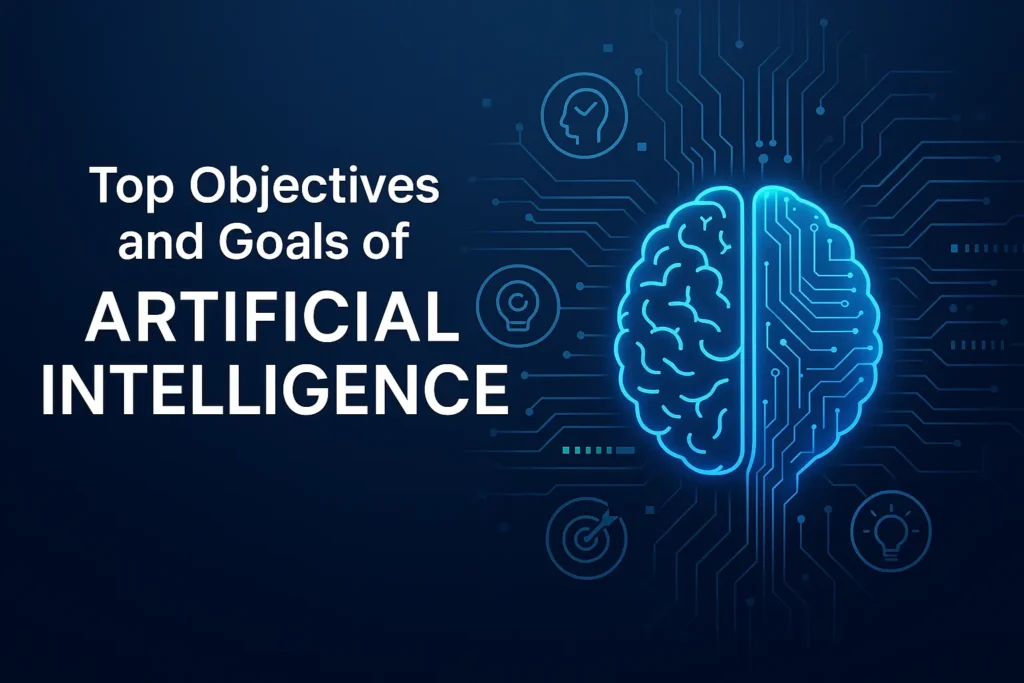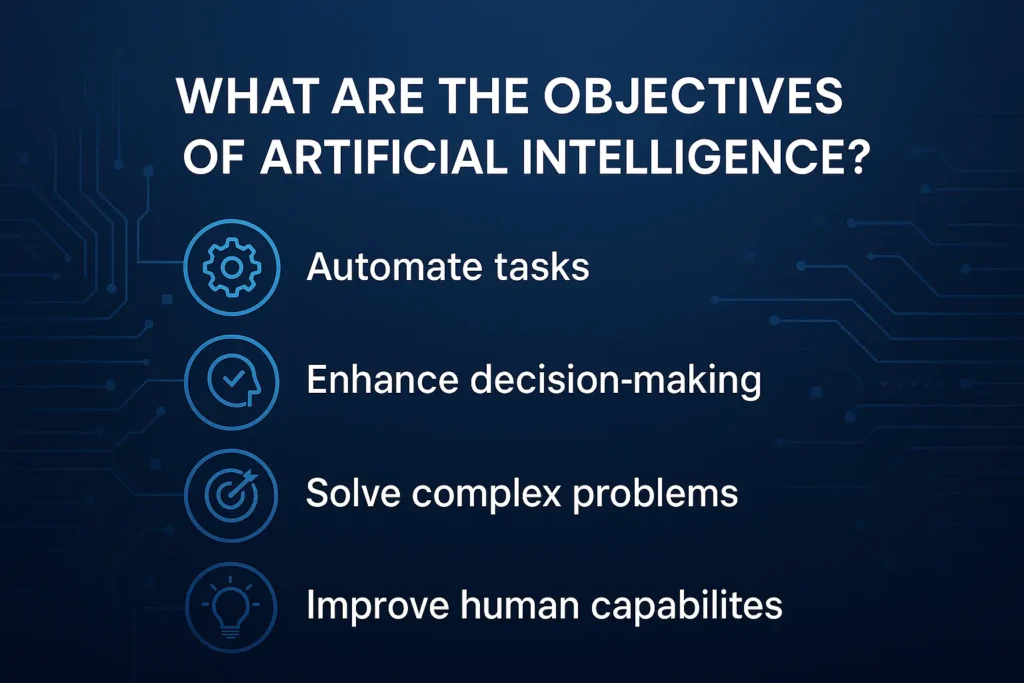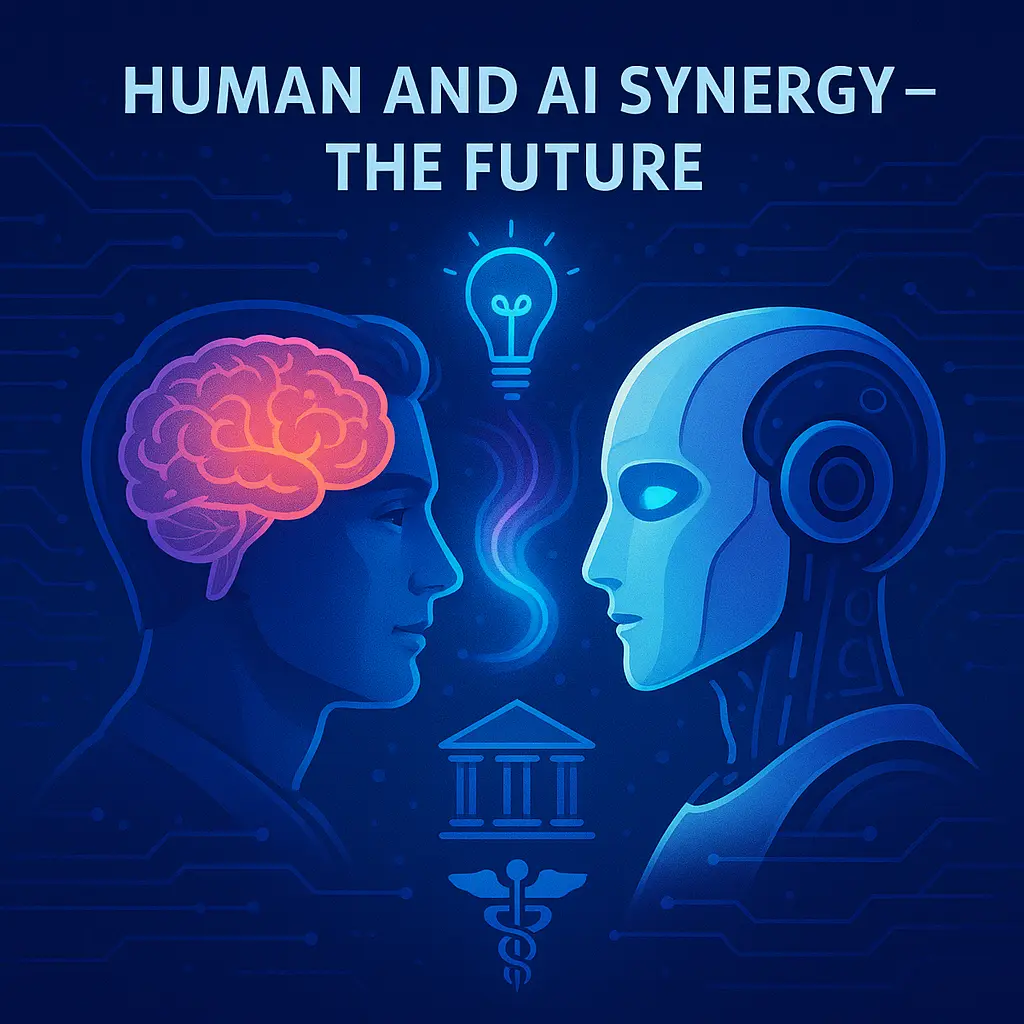In today’s rapidly advancing technological landscape, Artificial Intelligence (AI) has emerged as a transformative force shaping industries, lifestyles, and global innovation. Simply put, AI involves the development of intelligent computer systems capable of performing tasks that typically require human intelligence — such as learning, problem-solving, speech recognition, and decision-making. These capabilities reflect the objectives of AI and the broader aim of artificial intelligence: to replicate, augment, or enhance human thinking in meaningful ways.
Top Objectives and Goals of Artificial Intelligence Explained

Understanding what are the goals of artificial intelligence is crucial as we increasingly integrate these systems into our daily lives. Clarity around the goal of AI not only helps us leverage its full potential but also prepares us to address the ethical, social, and economic challenges that come with it. By aligning AI development with human values and long-term societal needs, we can ensure responsible innovation and reduce potential risks. In this way, a deep understanding of the objectives of artificial intelligence becomes essential for guiding research, shaping policies, and building a future where AI serves as a trusted and beneficial partner to humanity.
What Are the Objectives of Artificial Intelligence?
The objectives of Artificial Intelligence represent the fundamental aims that drive the design, development, and application of AI technologies. These goals of AI are not just theoretical; they guide real-world innovation and the practical implementation of AI across various sectors.

Here are the primary objectives of artificial intelligence:
- Mimicking Human Cognition This objective focuses on building machines that can learn, reason, problem-solve, perceive, and understand language in ways similar to humans. The aim is to replicate complex cognitive functions.
- AI Objectives Examples:
- Natural Language Processing (NLP): Enabling AI to understand human speech (like voice assistants) and translate languages.
- Computer Vision: Allowing AI to interpret and understand visual information from images and videos (e.g., facial recognition, object detection).
- AI Objectives Examples:
- Automating Tasks A key goal is to empower machines to perform routine, repetitive, and often mundane tasks efficiently and accurately, reducing the need for human intervention.
- AI Objectives Examples:
- Robotic Process Automation (RPA): Automating back-office operations like data entry or invoice processing.
- Chatbots: Handling customer service inquiries and providing instant support.
- AI Objectives Examples:
- Enhancing Decision-Making AI aims to provide data-driven insights and predictive capabilities, leading to faster, more informed, and accurate decisions in various fields.
- AI Objectives Examples:
- Predictive Analytics: Forecasting market trends or identifying potential fraud in financial services.
- Medical Diagnostics: Assisting doctors with early disease detection based on medical images or patient data.
- AI Objectives Examples:
- Solving Complex Problems This objective involves using AI to tackle intricate challenges that are beyond human computational capacity, by processing vast amounts of data and identifying hidden patterns or solutions.
- AI Objectives Examples:
- Scientific Research: Accelerating drug discovery, material science, or climate modeling.
- Logistics Optimization: Finding the most efficient routes for delivery services or supply chains.
- AI Objectives Examples:
- Facilitating Continuous Learning and Adaptation A crucial goal is to create AI systems that can learn from new data and experiences, continuously improving their performance and adapting to new situations over time without explicit reprogramming.
- AI Objectives Examples:
- Recommendation Engines: Personalizing content suggestions on platforms like Netflix or Amazon based on user behavior.
- Autonomous Systems: Self-driving cars continually learning from road conditions and driving scenarios.
- AI Objectives Examples:
- Augmenting Human Capabilities AI strives to assist and empower humans, allowing them to achieve more, be more productive, and focus on creative and strategic tasks by offloading less complex work.
- AI Objectives Examples:
- AI Assistants: Helping with content generation (e.g., drafting emails, writing summaries) or data analysis.
- Augmented Reality (AR): Providing real-time information or guidance in fields like manufacturing or surgery.
- AI Objectives Examples:
- Ensuring Safety and Reliability Especially in critical applications, an overarching objective is to develop AI systems that operate securely, minimize errors, and can be trusted to perform consistently and safely.
- AI Objectives Examples:
- Cybersecurity AI: Detecting and responding to digital threats to protect systems and data.
- Autonomous Transportation: Building self-driving vehicles with robust safety protocols to prevent accidents.
- AI Objectives Examples:
Understanding these core objectives of artificial intelligence is vital for anyone engaging with AI, from developers to policymakers and end-users. It guides AI development toward ethical practices and positive societal impact.
Core Goals and Tasks AI Aims to Achieve
Artificial Intelligence is meticulously engineered to replicate, enhance, and extend key cognitive functions. The following domains represent the essential areas where AI focuses its efforts, aligning with the broader objectives of artificial intelligence to support human endeavors across various industries and disciplines.
Problem-Solving
One of the primary goals of AI is to enable machines to tackle complex tasks that demand logical reasoning, strategic thinking, and predictive capabilities. Artificial intelligence problem-solving involves AI systems designed to simulate human-like thought processes to resolve challenges in real-time.
- AI systems are trained to analyze situations and devise solutions autonomously.
- They leverage algorithms to simulate human-like thinking and strategic planning.
- This ability is essential in situations that demand fast analysis and the best possible decisions.
AI Tasks and Duties Examples:
- Predicting stock market trends and optimizing trading strategies.
- Resolving complex scheduling conflicts in logistics and operations.
- Diagnosing system failures and recommending solutions in engineering and IT.
- Optimizing routes for navigation and supply chain management.
Learning and Decision-Making
fundamental component of intelligent systems is their inherent ability to learn from data and make informed choices. This core function, often referred to as AI planning and decision-making, allows AI to adapt and improve over time.
- AI learns from vast datasets and past experiences to refine future decisions.
- It enables businesses and systems to automate decisions with speed, accuracy, and consistency.
- This domain underpins many modern AI applications that require adaptive intelligence.
AI Tasks and Duties Examples:
- Providing personalized product or content recommendations to users.
- Implementing dynamic pricing algorithms in e-commerce based on demand.
- Conducting comprehensive risk assessments in insurance and banking sectors.
- Powering autonomous systems that make real-time operational choices.
Understanding Human Language and Emotions
Modern AI strives to interpret and respond to human communication in a natural and empathetic manner. This involves advanced capabilities like Natural Language Processing (NLP) and affective computing, allowing AI to understand context, tone, and even emotional nuances.
- Enables machines to interact with humans seamlessly through various communication channels.
- Facilitates the processing and generation of human language for diverse applications.
- Makes communication more accessible and inclusive with smart translation and interpretation tools.
AI Tasks and Duties Examples:
- Translating languages in real-time for global communication.
- Identifying customer sentiment in online reviews and social media posts.
- Providing empathetic and context-aware responses in therapy or support chatbots.
- Powering virtual assistants (e.g., Siri, Alexa) to understand and execute complex commands.
By excelling in these core areas, AI fulfills its overarching goals of AI and demonstrates its vast potential in addressing real-world problems, making informed decisions, and interacting seamlessly with humans, showcasing diverse AI objectives examples in action.
Unique & Emerging Goals of Modern AI
As AI technology evolves, its ambitions extend beyond traditional problem-solving and decision-making. Modern AI, particularly generative models, is focused on building smarter machines—AI that unlocks new dimensions of creativity, intelligence, and human-AI collaboration. This aligns with what is the main goal of generative AI: enhancing innovation while supercharging the human brain .These advancements redefine what machines can do and how they can partner with us in the digital age.
Creativity and Content Generation
One of the most exciting developments is generative AI—a type of AI that creates new content such as text, images, music, code, and even video. So, what is the goal of generative AI?
- Its aim aligns with what is the main goal of generative AI — to generate original, human-like content by learning from vast datasets, contributing to building smarter AI capable of creative output.
- Rather than just analyzing or responding, it can imagine, innovate, and assist in creative processes.
Real-world examples:
- ChatGPT writing blogs or essays.
- DALL·E generating artwork from text prompts.
- Adobe Firefly creating marketing visuals and manipulating images.
- GitHub Copilot assisting developers with coding suggestions and auto-completion.
Building Smarter, More Autonomous Machines
Another key objective is building smarter machines AI—systems that can reason, plan, adapt, and function with minimal human guidance in complex and often unpredictable environments.
- These machines are capable of autonomous learning and action, especially in dynamic settings.
- They integrate perception, decision-making, and physical interaction to operate independently.
Real-world examples:
- Tesla’s Full Self-Driving AI navigating roads and traffic.
- Boston Dynamics’ Spot robot performing inspections and navigating construction sites.
- AI used in space missions (e.g., NASA’s AI-driven rovers exploring Mars).
Enhancing Human Capabilities (AI Supercharging Human Brain)
Modern AI is also focused on amplifying human potential, often referred to as AI supercharging human brain capabilities. This involves AI acting as a cognitive partner to enhance human performance and well-being.
- AI acts as a cognitive partner—analyzing information faster than we can, helping in complex decision-making, and even enhancing memory or focus.
- Applications in healthcare, education, and research show how AI augments human intelligence rather than replacing it.
Real-world examples:
- AI-assisted surgery improving precision and reducing risks for medical professionals.
- Brain-computer interfaces (BCIs) enabling paralyzed patients to control prosthetic limbs or communicate.
- AI tutors that personalize education for students, adapting to individual learning styles and paces.
Modern AI isn’t just about automation anymore—it’s about co-creating with humans, pushing the boundaries of what’s possible, and shaping a future where intelligent machines work with us, not instead of us.
Human and AI Synergy – The Future

The future of artificial intelligence isn’t about machines replacing humans—it’s about collaboration. The true strength lies in the synergy between humans and AI, where both work together to achieve greater outcomes than either could alone. This collaboration is already reshaping the way we live, learn, and work.
In Business: AI as a Strategic Partner
AI is revolutionizing business by streamlining operations, enhancing customer experiences, and unlocking data-driven insights. The synergy between humans and AI in business allows professionals to make faster, more informed decisions and gain a competitive edge.
- Human professionals use AI for faster decision-making, market forecasting, and personalized customer service.
- AI streamlines monotonous work, empowering humans to focus on high-level decision-making and problem-solving.
Synergy in action:
- Marketers use AI to analyze customer behavior patterns and automate targeted campaigns, while human strategists refine the messaging and overall brand vision.
- Sales teams rely on AI-powered Customer Relationship Management (CRM) systems to track leads and improve conversion rates, with human sales representatives building relationships and closing deals.
- Executives use predictive analytics generated by AI to guide business strategy, leveraging human intuition and experience for nuanced interpretations and ethical considerations.
In Education: Personalized and Inclusive Learning
AI is making education more accessible, personalized, and effective. The synergy between humans and AI here enhances teacher productivity and student engagement, creating more dynamic learning environments.
- Teachers use AI tools to tailor learning experiences based on individual student needs, providing personalized content and adaptive assessments.
- Students benefit from virtual tutors, real-time feedback, and adaptive learning platforms that adjust to their pace and style.
- AI also plays a role in content platforms like YouTube, where YouTube monetization policies are influenced by AI-driven detection systems that assess content quality, originality, and user engagement—relevant for educators sharing learning content online.
Examples:
- Duolingo’s AI-driven language coaching provides personalized practice, while human instructors offer deeper cultural context and conversational practice.
- AI systems detect students’ learning gaps and suggest targeted interventions, allowing human educators to provide focused support.
- Virtual classrooms powered by intelligent systems offer immersive learning experiences, with human teachers facilitating discussions and critical thinking.
In Healthcare: Smarter, Faster, More Human-Centered
Healthcare professionals are increasingly using AI to improve diagnostics, treatment plans, and patient care—all while still relying on human empathy and expertise. The synergy between humans and AI in healthcare leads to more precise, efficient, and ultimately more human-centered medical practices.
- Doctors use AI to detect diseases early through advanced imaging and pattern recognition, but human medical expertise remains crucial for diagnosis and treatment planning.
- Nurses and caregivers rely on AI for monitoring patient vitals and generating alerts for critical changes, allowing them to provide timely human intervention.
Synergy in healthcare:
- AI suggests highly personalized treatment options based on vast medical data, but doctors make the final, compassionate decision, considering the patient’s unique circumstances and preferences.
- AI chatbots assist with basic health queries and appointment scheduling, freeing up medical professionals for complex cases and direct patient interaction.
- Wearable AI devices track chronic conditions and alert patients and caregivers in real-time, enabling proactive health management with human oversight.
A Collaborative Future
The synergy between humans and AI is not a futuristic dream—it’s a present-day reality that’s growing stronger. Looking ahead, this collaboration will keep working to:
- Increase efficiency and productivity across all sectors.
- Enhance human creativity and innovation.
- Solve global challenges that require complex data analysis and rapid response.
Together, humans and AI are not just coexisting—they’re co-evolving toward a smarter, more connected world.
Conclusion
In summary, the objectives of artificial intelligence span a wide spectrum, from replicating human cognitive functions like problem-solving and learning to pioneering new frontiers in creativity and human augmentation. The overarching goal of AI is to build intelligent systems that not only automate tasks and enhance decision-making but also foster a powerful synergy between humans and AI. This collaborative future promises to unlock unprecedented potential across business, education, healthcare, and beyond, driving innovation and addressing complex global challenges by working together.
We invite you to share your thoughts on the evolving role of AI or share this article with others who might find it insightful!